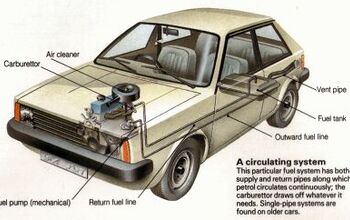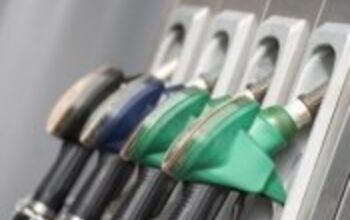Piston Slap: Fuelish Thoughts on Engine Calibration

TTAC regular PrincipalDan writes:
Sajeev,
With the price of gas dropping to levels not seen in many moons, a thought occurred to me: Many of us are driving around in an average vehicle that has an engine used by another vehicle advertised as having more horsepower and recommending premium fuel.
For example: Toyota’s 3.5-liter V6 powers the Camry and ES350, but the Toyota’s tests with 87 octane fuel while Lexus tests with 91 octane fuel.
Do the manufactures actually bother using different engine programing in these various vehicles? Or is greater horsepower just a premium fill-up away for those with lowlier vehicles with premium antecedents?
I know there is no benefit to using high-octane fuel in an engine not designed for it, and I wouldn’t suddenly put my Highlander on an all premium diet, but I think I’m asking a relevant question.
Sajeev writes:
Manufacturers often use a unique engine calibration for different models using the “same” engine. Justification for a unique part number is in the eye of the beholder, but occasionally unique engine parts need a unique engine calibration. Peep the 32-valve mill in the Lincoln Mark VIII vs. the Cobra offshoot, or more recently the LSA vs. LS9 story. I don’t expect this from a Lexus ES vs. Camry V6 comparison; it’s named entry-level luxury for good reason.
For the ubiquitous Toyota 3.5-liter V6, the Lexus ES has not required premium fuel since Toyota implemented direct injection, so I went back in time. The (non-direct injected) 2010 ES burns premium while the 2010 Camry consumes regular. The benefit? An extra four horsepower and an extra six pounds-feet of torque at the same revs over the Camry.
Such a power bump is totally worth the bragging rights, and the extra cash spent at every fill-up. Or not.
Unique tunes help computers make the ideal vehicle for whatever need, while saving money by re-using parts. Perhaps the Lexus’ engine calibration has smoother transmission shifts, integration of more tech, etc.
What say you, Best and Brightest?
[Image: © 2012 Alex L. Dykes/The Truth About Cars]
Send your queries to sajeev@thetruthaboutcars.com. Spare no details and ask for a speedy resolution if you’re in a hurry…but be realistic, and use your make/model specific forums instead of TTAC for more timely advice.

More by Sajeev Mehta
Latest Car Reviews
Read moreLatest Product Reviews
Read moreRecent Comments
- Daniel J Cx-5 lol. It's why we have one. I love hybrids but the engine in the RAV4 is just loud and obnoxious when it fires up.
- Oberkanone CX-5 diesel.
- Oberkanone Autonomous cars are afraid of us.
- Theflyersfan I always thought this gen XC90 could be compared to Mercedes' first-gen M-class. Everyone in every suburban family in every moderate-upper-class neighborhood got one and they were both a dumpster fire of quality. It's looking like Volvo finally worked out the quality issues, but that was a bad launch. And now I shall sound like every car site commenter over the last 25 years and say that Volvo all but killed their excellent line of wagons and replaced them with unreliable, overweight wagons on stilts just so some "I'll be famous on TikTok someday" mom won't be seen in a wagon or minivan dropping the rug rats off at school.
- Theflyersfan For the stop-and-go slog when sitting on something like The 405 or The Capital Beltway, sure. It's slow and there's time to react if something goes wrong. 85 mph in Texas with lane restriping and construction coming up? Not a chance. Radar cruise control is already glitchy enough with uneven distances, lane keeping assist is so hyperactive that it's turned off, and auto-braking's sole purpose is to launch loose objects in the car forward. Put them together and what could go wrong???


































Comments
Join the conversation
In my shadetree-wrenching experience, which ended as FI became the standard...premium-fuel stipulation came from high-compression specifications. In those dying years of carburetion, there were engines made to run a fine line, where 89-octane regular was stipulated but occasional engine ping would penetrate the Tears-For-Fears playing on the tinny factory speakers. Switching to 91 usually stopped it. Cut driving time down, too - more cost-per-mile equals less miles-per-week. Just dumping premium fuel in there, does not, IMHO, translate to better performance. I had tried this years ago with a K-Jetronic-powered VW Fox; and later with more-sophisticated FI products including a Wrangler and several Tacomas. No appreciable difference - except in the cost of fill-up. If the modern techno-mechanics find me wrong here, feel free to correct.
I have a 1997 ES300 that I've owned from new. The owners manual states 87 octane required, 91 recommended. The 1MZ-FE engine is rated at 200 hp. The 97 Toyota Camry used the same 1MZ-FE engine, but rated at 194 hp. It's owners manual also states 87 required, 91 recommended. I've always used 87 in mine. A couple of years ago, after one of those regular vs premium debates on a Lexus forum, I decided to try it out for myself. I use this car primarily for commuting to work, same route, same speeds, same time of day, so my mileage is very consistent, excluding mostly highway trips it averages around 20.5 mpg. For the last 4 tanks before switching to 91, 1188 miles, I averaged 20.7 mpg. For the next 4 tanks I used 91, 1215 miles, and averaged 21.2 mpg. For the next 4 tanks using 87, 1226 miles, I averaged 20.6 mpg. Overall I got about 2.6% better fuel economy using 91, though I doubt it is statistically significant difference. At that time, 87 was around $3.30 and 91 was $3.70, about 12% more for 91. Today 87 was 1.89, 91 was 2.29, about 20% more. I did the same thing a few months later, with close to the same results, about a 2% increase with 91. I tried it again later with E0 89 instead of E10 87, with similar results; slightly better fuel economy, but not nearly enough to offset the increase in price. The engine doesn't feel any smoother on 91, or the car any "peppier", and it doesn't get enough better mileage to offset the extra cost. I suspect that some of the folks who believe their cars run much better using premium wouldn't be able to tell if they didn't know what was in it. Your mileage may vary.